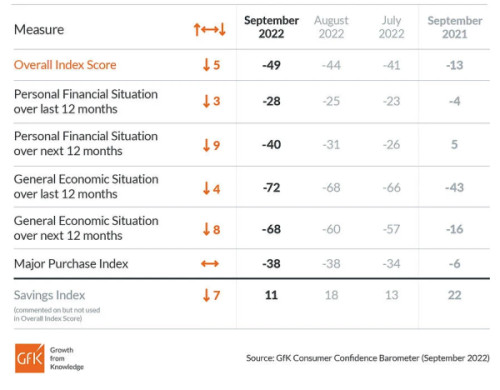Somewhat unsurprisingly, consumer confidence in the UK plunged to a new low this month as people grew increasingly concerned about the outlook for the economy and their personal finances.
Figures from GfK’s UK Consumer Confidence Index show that the overall score had decreased by five points in September to -49 ‒ the worst result since records began in 1974.
Four measures were down in comparison to the August announcement, and one was flat:

The overall fall defied economists’ expectations of a small improvement in the index following the government’s multi-billion package aimed at freezing household energy bills and easing the pressure on consumers.
However, Joe Staton, client strategy director at GfK, said: “Consumers are buckling under the pressure of the UK’s growing cost-of-living crisis driven by rapidly rising food prices, domestic fuel bills and mortgage payments. They are asking themselves when and how the situation will improve.”
Earlier today, the Chancellor Kwasi Kwarteng outlined a series of tax cuts and economic measures in a shake-up designed to boost economic growth.
Meanwhile, data published by Asda confirms that the majority of UK households are notably worse off compared to this time last year as spiralling living costs continue to outstrip wage growth.
According to the Asda Income Tracker, average household disposable income fell by £32.32 a week in August – equivalent to £129.28 per month – whilst one in five households had a negative disposable income of £60.
Despite annual wage growth of 5.5% in the three months to the end of July, 80% of UK households were worse off in real terms due to an 11.8% increase in spending on essentials such as rent, mortgage payments, fuel, groceries, and transport costs. The only households to buck this trend were those in the highest income quintile, who saw their disposable incomes increase by 0.3% year-on-year.
Economists expect the squeeze to result in falling spending, a trend confirmed by the Bank of England in its agents survey published this week.
It showed that food retailers reported customers opting for cheaper goods and cutting back on non-essential items, such as confectionery. Discount chains gained market share, while sales of household items, such as furniture, electrical goods and home improvement products, fell.
Clothing sales were supported by the return to the office, but in hospitality, sales were down on pre-pandemic levels. Holiday bookings also weakened and domestic tourism was limited by higher petrol prices.
NAM Implications:
- ‘…as people grew increasingly concerned about the outlook for the economy and their personal finances…’
- Understatement?
- In business, especially as NAMs, we are accustomed to dealing with uncertainty.
- Think what this all means to everyday consumers, following three unprecedented years…!
- There has to be a tipping point?
- In other words, what action will the consumer take when they decide ‘enough is enough’?



